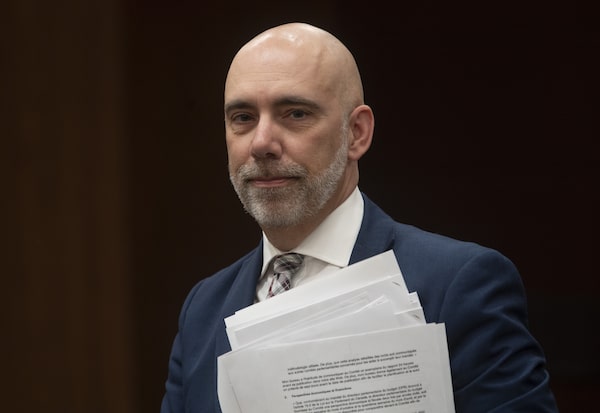
Parliamentary Budget Officer Yves Giroux is seen on Parliament Hill, in Ottawa, on March 10, 2020.Adrian Wyld/The Canadian Press
The Liberal government’s plan to create 10,000 jobs by funding and promoting sector-based innovation “superclusters” is far behind schedule and is unlikely to create the promised employment gains, according to a new report by the Parliamentary Budget Officer.
But heads of all five supercluster bodies said project approvals are picking up after an initial two years focused on building their organizations and seeking proposals. It also took Ottawa months to finalize contribution agreements to the program, which was announced in the 2017 budget.
Moreover, the heads said the PBO did not contact them about concerns in the report – including the complaint that the government did not share any “quantifiable performance indicators” about the program with the office.
“I would have been happy to have had a conversation with [the PBO] about the accomplishments and key performance indicators we’re tracking,” said Bill Greuel, chief executive officer of the Protein Industries supercluster, based in Regina, which funds projects in Canada’s plant protein sector. “It would have helped tell a more comprehensive story.”
Industry critics counter that the watchdog’s findings confirm concerns that the program is flawed and fails to ensure Canada benefits from the intellectual property (IP) it creates.
Tuesday’s report by Yves Giroux and his PBO staff takes a closer look at the $918-million in spending Ottawa promised in 2017. Called the Innovation Superclusters Initiative, the government said it would target money at specific industries and regions to promote job creation in sectors with strong potential.
In February, 2018, the government announced five superclusters: a Digital Technology supercluster in British Columbia and similar bodies dedicated to plant proteins on the Prairies, advanced manufacturing in Ontario, adding artificial-intelligence capabilities to supply chains in Quebec and an Ocean supercluster based in Atlantic Canada. In each supercluster, a government-mandated agency would work with companies and researchers to fund collaborative projects aimed at creating startups, jobs, IP and economic activity.
The report compared the government’s planned spending schedule to results as of March 6, 2020. The PBO found just $30-million of the anticipated $104-million had been spent by then, 29 per cent of original projections. The Globe reported in March that supercluster funding was falling behind.
But the supercluster CEOs told The Globe there has been a sharp pickup in the number of approved projects since then. For example, the Ontario supercluster has approved 60 projects and committed $114-million of its $230-million allocation, up from $47-million at the end of March.
The protein supercluster, after announcing one project in 2019, has unveiled 10 more this year, including an $11.4-million research and development project between AGT Food and Ingredients and pulse-products startup ulivit, both based in Saskatchewan, to develop food products for consumer and restaurant markets. The Prairie supercluster has committed $100-million of its $153-million allotment from Ottawa, matched by $172-million from industry partners, and should be fully committed by March, ahead of plans, Mr. Greuel said.
Both the B.C. and Quebec superclusters said they’re also ahead of plans. The Ocean supercluster, meanwhile, has approved 26 projects this year after approving six in 2019, including a $20-million project led by Newfoundland-based Kraken Robotics Inc. to develop technologies that provide ultra-high-definition imaging, mapping and analytics of the sea floor.
Kendra MacDonald, the St. John’s-based CEO of the supercluster, said “it probably took a little more time than we anticipated when we got started,” in part because her group brought together sectors such as fishing and offshore oil drilling that hadn’t worked together before. The group has now committed over half its $153-million allotment from Ottawa. The PBO report “is a reminder of how far we’ve come in the last six months,” she said.
The PBO report also challenges the government’s job creation numbers and underlying GDP assumptions.
It notes that the federal department of Innovation, Science and Industry, led by Innovation Minister Navdeep Bains, projected that the $918-million in federal spending, combined with $1.1-billion from non-federal partners such as universities, the private sector and provincial governments, would increase GDP by $50-billion over the following decade. The PBO notes that this works out to an assumption that the GDP increase would be 25 times the original spending.
Yet the PBO was unable to find any international research to support the claim of such dramatic increases to GDP through spending on research and development, saying the typical multiplier is usually between three and eight times the investment. As a result, the PBO said “it seems highly unlikely” that the program will boost GDP by $50-billion over 10 years.
Ottawa-based intellectual property lawyer Natalie Raffoul said Canada has a poor record of ensuring research and development support leads to IP rights that are commercialized to Canada’s benefit. She called this Canada’s “innovation philanthropy” problem, in which tax dollars fund research that is commercialized by foreign companies.
“It was totally foreseeable,” she said of the PBO’s supercluster concerns. “A major flaw is that there was no IP policy framework that was set up.”
Council of Canadian Innovators chair Jim Balsillie, who has long expressed similar concerns, said the promised job gains from the superclusters were not realistic.
“If this program had commenced with an IP and data strategy, we could be driving needed economic outcomes within a normal range rather than non-innovation innovation dreams,” he said.
Mr. Bains, the Innovation Minister, provided a statement in defence of the program Tuesday.
“We are seeing the five superclusters live up to their promise in terms of leveraging industry contributions, and supporting collaborative projects with small and medium-sized enterprises which are having a national impact,” he said. His office added that the program includes a “comprehensive” approach to IP.
Know what is happening in the halls of power with the day’s top political headlines and commentary as selected by Globe editors (subscribers only). Sign up today.
 Bill Curry
Bill Curry Sean Silcoff
Sean Silcoff